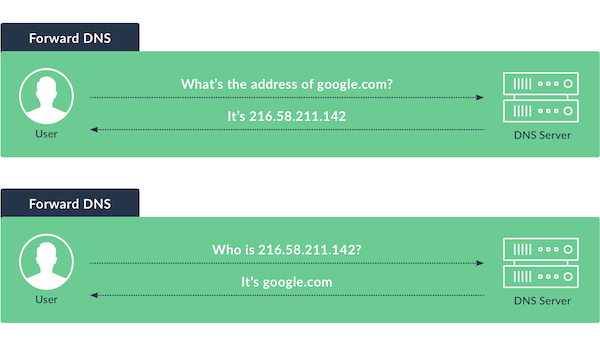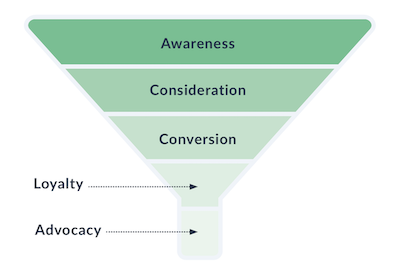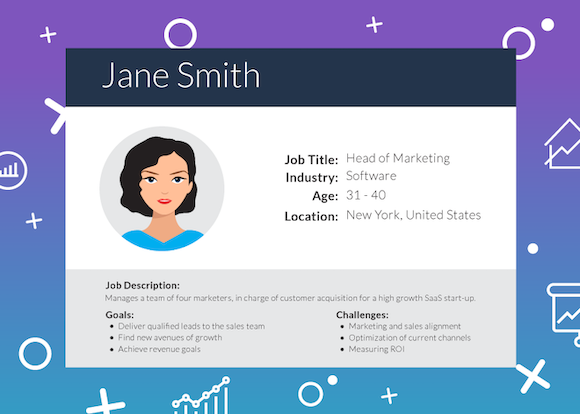Your Complete Guide to Website Visitor Tracking
Discover all there is to know about website visitor tracking and how to monitor who enters your marketing and sales funnel.

Source
Those statistics can be discouraging for sales and marketing teams, especially when you've worked so hard to drive traffic to your website. You must make sure the visitors you attract are converting and maximize the value from the 98% of website traffic that doesn't initially convert.
Understanding how to track traffic to a website and extracting more value from existing visitors makes your marketing department instantly more efficient because they know where to focus their efforts.
For sales teams, this means higher-quality leads from current lead generation efforts, reducing the need for constantly investing in new channels to drive fresh leads. Instead, they can nurture the potential customers already in the pipeline.
So, how do you stop missing sales opportunities and encourage site visitors to buy?
Website visitor tracking software can shine a light on the unidentified 98% of non-converting traffic. It’s the best way to uncover and make the most of hidden opportunities.
In this guide, you’ll discover:
- What website visitor tracking is and how it works.
- How to use B2B website visitor tracking software to bolster current growth, sales, and marketing strategies.
- The detailed approach two companies employed to secure more deals through website tracking.
All set? Let’s get started.

What is website visitor tracking?
The people visiting your website don’t have to be a mystery. It isn’t difficult to capture website visitor information.
Sure, you can look in your Google Analytics dashboard, but don’t you also want to know who is behind each pageview? Who they are, where they work, and, more importantly, whether they’re a potential lead you should follow up with.
Website visitor analytics tools make that possible.
The software used to track website visitors reveals information about the people visiting your website that isn’t easily available in analytics platforms, such as Google Analytics. You can view company names and contact information for key people at the company, which enables sales and marketing teams to build accurate customer profiles.
That, in turn, gives you the ammunition you’ll need to generate and convert more high-quality leads.
Why? Because:
- Marketing teams have data to build a stronger strategy. They can view which content their top prospects are engaging with and learn which traffic sources bring more ideal customers to the site while generating more leads from current traffic and implementing more robust ABM campaigns.
- Sales teams are given company names of people browsing, enabling them to find warm leads already looking for the product or service you provide. This reduces the need for aggressive sales tactics and slashes the time they’ll spend finding their own leads to reach out to. Instead, they’re more efficient with their time–and can focus on leads that will improve revenue.
(And, truth is, companies, where sales and marketing teams work together, see 36% higher customer retention, and 38% higher sales win rates.)
What does that mean for your company?
Well, your marketing team can generate quality leads without increasing media spending. By fine-tuning your process with feedback from your sales department, you’ll refine your marketing strategy and focus more on channels that bring those dream customers to your site.
That’s bound to help shorten the gap between the 2% of website visitors who convert, and the 98% who don’t.

How does website traffic tracking work?
So, how exactly does web visitor tracking find the names of companies browsing your website?
Spoiler alert: You don’t need to be hugely tech-savvy to understand how to track website traffic.
Reverse Domain Name System (rDNS)
All internet-connected devices have an IP address, and the majority have what’s called a reverse DNS record.
Website visitor tracking, like Leadfeeder, uses reverse DNS to find which companies are visiting your website based on their IP address.
The best part? Visitor tracking software can also filter out ISPs, bots, and spammy traffic, leaving you with a neat list of real companies that are visiting your website.
For example, if you type an IP address of “8-8-8-8-8” into an rDNS tool, it’ll give you the location – and, therefore, the company using it. It’s essentially the same as looking up a phone number in an address book but for websites.

Script
Website visitor tracking software works by installing a script on your website that collects the website visitor data directly.
Your software will then connect the dots, and reveal which companies are browsing your site.
Then, the collected data is commonly subjected to data enrichment processes, incorporating publicly available information about the company, such as:
- Employee numbers
- Address
- Website
- Social media profiles
- Company contacts
…allowing you to get a detailed profile of companies visiting your website.
Syncing your tool stack
Do you store data about current leads? Whether it’s from your CRM, marketing automation software or communication tool you use to speak with potential customers, you can integrate your tool stack to get more information on the people browsing your website.
For example: If you’ve noticed a dream customer visiting your website (“Company A”), you’ve got two options:
- Create a new organization in your CRM, where your sales team can begin monitoring them and marketers can use this data to build better ABM campaigns.
- Sync the website browsing data you’ve collected with the organization in your CRM if they are already listed there. This will give you a more detailed profile of the lead you’re nurturing.
You’ve got a better understanding of the organizations visiting your website, and a plan of action to convert them directly from your CRM–even if they haven’t got a profile in there, yet.
Is it GDPR compliant?
A very valid question to ask–especially when not meeting GDPR rules could land you a hefty fine of up to €20 million, or 4% of your company’s annual turnover.
GDPR, introduced on 25th May 2018, protects someone’s privacy (specifically online). It means businesses must be transparent with the data they hold on their EU-based audience and be willing to delete it at their request safely.
How does that work with tracking software, when you’re essentially gathering data on your website visitors?
Good news: the way Leadfeeder processes data is compliant with GDPR legislation – so as long as you’ve got a clear privacy, terms, and cookies policy visible on your website that:
- Is easy for visitors to access (with links from your footer and email opt-ins)
- Includes how the data your tracking is used

How can website tracking tools drive growth?
Great! You’re able to track the people visiting your website, put company names to website clicks, and learn more about individual activity taking place on your site. But how exactly do you use that data in your growth marketing strategy?
Lead generation
Outbound leads cost 39% more than inbound leads, so it’s no surprise marketers are looking to improve their lead generation efforts and attract customers who’re likely to convert.
However, you’re probably relying on CRO tactics, content marketing, and paid media to generate leads from your website. That’s a great place to start.
But you can supercharge the ROI from each lead generation tactic when you add website visitor tracking into the mix because you’re able to:
- See the exact profile of companies browsing your website–including key details like industry, employee size, location, and the names of employees who can be targeted.
- View typical pre-purchase behaviors, and prioritize nurturing new site visitors who demonstrate the same behaviors.
- Analyze the companies clicking on your PPC campaigns, and track exactly what they do on your website.
- Locate the exact page a target lead converts (or exits) on your website.
In short: With website tracking, you can identify high-value potential leads who’re passing through your funnel, sync them to your CRM, and pass them along for sales teams to nurture.
The best part? It can be done even if they don’t actively fill-in a lead capture form (such as an eBook download) on your website.
By using Leadfeeder for online lead generation we’ve increased the amount of qualified sales leads by 34%. We send website leads directly to our Pipedrive using Leadfeeder’s Pipedrive integration. Steve Jackson, CEO, Quru
The marketing funnel
Unfortunately, it’s tough to convince a first-time visitor to convert.
People go through a journey before handing over their hard-earned cash in return for a product or service, which is why you’ve likely got a marketing funnel to nurture each lead as they flow throughout various stages.

But where does website visitor tracking software fit into the mix?
The answer: From “awareness” to “conversion”.
Collecting data on your customers’ website activity at each key stage of the marketing funnel before making a purchase, means you can use it to your advantage.
Knowing the exact companies progressing through your marketing funnel (as opposed to generalized traffic numbers and conversion rates) can help you plug holes. You’ll know where previous leads dropped off and be able to fix those issues to move them through the entire funnel faster.
Here’s how I might use that if I’m a B2B SaaS company, and want to understand how people travel through my website on their journey from anonymous visitor to customer:
- Awareness: I’ve just published a new blog post on my website, and it’s already driving a decent amount of traffic via organic search. But, I want to understand which companies view it, so I use visitor tracking. Based on the data being fed back, I can see the industry and company size of each visitor and build up a more accurate profile of the type of company suffering from the pain point my blog post targets.
- Consideration: I’ve built a landing page that explains how my SaaS solution solves the pain problem discussed in my blog post. Now, I can create an ABM advertising campaign on LinkedIn, targeting the specific companies who viewed the initial blog post and pushing them toward the landing page. Based on my data, I can also build a list of similar-sized companies in the same industry and target them, giving me a large pool of high-value potential prospects to target.
- Conversion: I set-up custom feeds and alerts in my visitor tracking software to send my sales team an email (or Slack message) when each target company visits the landing page. Then, they’ll check the lead’s previous website activity, sync the data to our CRM, and find the best person to contact. It’s only a matter of time before we make the sale!
Regardless of how you’re using data shown within website visitor tracking software, your overall growth strategy becomes less of a numbers game based on anonymous traffic. You’re shining a light on people already browsing your website and using their activity to target them with personalized campaigns.
That lets you align your sales and marketing departments and effectively take each target prospect through the funnel.
My role is to generate leads that fill up our sales funnel—or the top of the marketing funnel. We use Leadfeeder to figure out which prospects are visiting our website and the best way to reach out to them. Maybe they haven't yet reached out to us, either, but now we can be proactive in marketing to them and getting them into our sales funnel. Julie Huval, Head of Marketing, Beck Technology Ltd
Account-based marketing (ABM)
You’re already one step ahead if you’ve started to implement ABM into your marketing strategy.
87% of B2B marketers have agreed that ABM delivers a higher return on their investment than other marketing activities, and companies already using ABM generate 200% more revenue for their marketing efforts.
You’re able to use the data inside your website tracking report to improve your ABM campaigns even further by:
- Building more accurate profiles of your ideal companies, and targeting them through ABM campaigns, based on the types of companies visiting key pages on your website.
- Assessing the performance of your current strategies by identifying the companies browsing your site from various campaigns.
- Powering ABM campaign targeting across several platforms, such as LinkedIn and display advertising, using the data you’ve collected on each company.
Let’s say you want to get started with ABM but are unsure who your ideal target should be. You can use visitor tracking to see which companies visit your website's pricing and product pages, which people view when they’re closer to a conversion.
You build a profile for each company visiting those pages and begin marketing to similar companies with the same qualities (such as industry, company size, or location).
Two weeks pass, and you check the data in your visitor tracking software again. Boom! You can see which companies have engaged with your campaign and visited your website.
You know your ABM campaign is paying off because Company A has visited your pricing page, so your sales team reaches out to the decision-maker at Company A via LinkedIn. They already know the content and campaigns their target has engaged with, so the sales reps can personalize their outreach.edIn. They already know the content and campaigns their target has engaged with, so the sales reps can personalize their outreach.
Then, after warming up the prospect, they send a personalized pricing plan for a company of their size and book a software demo to convert them into customers.
We use the data from Leadfeeder to build ABM campaigns across LinkedIn and Google. By targeting job functions within the company, and not just the individual website visitor, we get the opportunity to influence multiple stakeholders in the buying process. We automate the process via Leadfeeder’s Zapier integration. So far we've reduced the length of our sales process by 20% and the marketing team is generating substantially more targeted leads for sales than before. Casper Rouchmann, Traffic Manager, Templafy

Website visitor tracking software: 6 practical uses for marketing departments
Earlier, we talked about how the data provided by website visitor tracking software can help you generate more leads and drive growth for your company. But if you’re looking for some more actionable takeaways that you can implement straight away to assist your marketing campaigns, here are six practical uses.
1. Build accurate buyer personas

Source
If you read any good “marketing guide,” you’ll find buyer personas on the list.
Buyer personas are documents that define your ideal customer. They include key traits like their age, job title, interests, location, and pain points, and allow you to understand exactly who you’re targeting.
(Not convinced? Consider this: Buyer personas make websites 2-5 times more effective, and helped one company to increase the volume of leads sent to sales by 10%, while also reducing their lead conversion time by 72%.)
You should have buyer personas for each “type” of ideal customer you want to attract. If you have multiple–like agency owners and in-house marketers, for example–create a different buyer persona document for each one. Over 90% of a company’s sales come from 3-4 buyer personas, so don’t be afraid of creating more than one.
But where does website visitor tracking fit into buyer personas?
The answer: When you’re creating them. All buyer personas you create should be data-driven–not based on guesswork.

Presuming that your target customers have a certain quality is dangerous because you might spend hours targeting people who fit the mould but don’t convert. That won’t do any favors for your conversion rates (nor make sales departments very happy).
Instead, use data to get your facts straight.
Adding website tracking to the mix will strengthen your buyer personas even more. You’ll be able to view the characteristics (such as industry, employee count, and location) of each company visiting your website and learn how they move through the buyer journey to conversion. Start by examining the people visiting your website and giving them a lead score.
For example:
- Company A has a lead score of 8: They work for LinkedIn (one of your dream customers), have visited your services page, and read three relevant blog posts.
- Company B has a lead score of 1: They work for a smaller company with three employees and read only one blog post before hitting the exit button of their browser tab.
You’re more likely to focus your lead generation efforts on Company A, right?
If you find a similar pattern across the board (such as content consumption, company size and referral website), build them into your buyer persona documents. Your marketing team will then have a better understanding of the leads they’re trying to bring in–and focus on strategies that’ll make it happen.
2. Map the buyer’s journey

Source
Do you know the process a person takes to go from “stranger” to “customer”?
If not, website visitor tracking software can help.
You’re able to view both company and individual browsing data to understand how people flow through their journey to purchasing and answer key questions like:
- How many pages do my customers view before purchasing?
- Which pages do they spend the most time on?
- Which marketing channels are driving leads to our website at each stage of the buyer journey?
That data is invaluable for marketers because it helps you boost conversion rates through improving buyer journeys for your potential customers.
Let’s put it into practice using the questions above:
- 95% of my converting website traffic views 5+ pages before purchasing, so I’ll add more internal links in my content and improve my navigation bar to make that easier for future visitors.
- People who convert spend a lot of time viewing my About page (2.5 minutes), so I’ll improve the overall design and use storytelling on that page to build relationships.
- 30% of my conversions come directly from Google AdWords, but only 3% come from Facebook Ads. However, 20% of conversions clicked on one of my Facebook Ads earlier in their journey, but the lack of conversions shows they’re not ready to purchase yet. So, I’ll change the focus (and content) of my Facebook ads to educate buyers in the middle of their journey, as opposed to trying to drive a direct sign-up.
Remember: Each conclusion is based on facts and hard data, not guesswork. That’s the aim with any new marketing strategy.
3. Support your content strategy

Source
Content marketing is a strategy that must be integrated into your overall marketing plan–that’s no secret.
But with website visitor tracking and data from Google Analytics, you can make your entire process more streamlined by understanding exactly which content you should be focusing on.
For example: Look at how the companies you’d love to work with are engaging with your current content, and ask yourself the following questions for each target lead:
- Who’s reading what content? Focus on whether certain types of companies are reading particular types of content–whether that’s listicles, long-form content or text based around infographics. Then, create more of the content your target companies are reading.
- How long do they typically spend on a piece of content? If it’s not much time, consider shortening the length or formatting the page so it’s scannable.
- How do they find these blog posts? If a huge chunk of them arrive from organic search, focus on SEO and put more effort into optimizing each page for a highly converting keyword.
- How many blog posts do they typically read before converting? If it’s more than one, add internal links to other assets in your library to encourage further reading for new website visitors.
4. Assist lead generation

Source
Because website visitor tracking shows you which companies or individuals are visiting your website, you can sync them to your CRM dashboard and track their conversion likelihood.
Again, that gives tons of meaningful data you can use to help with lead generation.
For example, you know the type of companies downloading your lead generation content, but do you know the ones that aren’t engaging—or the ones that you wish were?
Figure out the type of companies coming to your website and not becoming leads, then search for a way to start turning those companies into leads. That could include:
- Creating downloadable content, such as eBooks or whitepapers, more specifically tailored to those companies’ industries, interests or pain points.
- Adding more specific calls to action on your website that speak to those companies pain points, rather than generic buttons like “sign-up”.
- Building different landing pages for each stage of those companies’ buyer journeys, and experimenting with other lead generation tactics–such as using live chat software to open a conversation when they’re actively browsing your website.
The same concept applies for driving initial traffic.
If your target customer is similar to QuickBooks (who’ve already visited your website), take a look at where they arrived from. Was it organic search, from a LinkedIn ad, or from an external blog post you were mentioned in?
Alternatively, if a company hasn’t downloaded a lead generation asset, but fits your target customer and is showing a high level of intent (such as visiting a product or pricing page multiple times), send them directly to your sales team. They’ll be able to source the ideal contact at the company using data in your visitor tracking platform and reach out to them directly, with the hopes of bringing them on as a customer.
5. Build stronger ABM campaigns

Source
Account-based marketing happens when you’re taking an uber-personalized approach to bring your target on as a customer. It provides each target customer (or “account”) with marketing material that’s tailored to their budget, company and individual requirements.
Let’s say you’re attempting to get an ABM program off the ground, for example. You aren’t entirely sure where to start, or you’re looking for a way to improve the ABM strategy you’ve had in place for a while that isn’t getting as many results as you’d hoped.
You can use website visitor tracking to:
- Analyze the companies visiting your website, including how they browse it and what channels they use to find you, to help build profiles of your ideal accounts. With this data, you can evaluate which methods will likely to be most effective when connecting with them. For example: If your dream customer arrives through a LinkedIn post, send a direct message through LinkedIn to your contact.
- Create lists in your visitor tracking platform of specific companies you’re already targeting, and understand how your current efforts are performing. For example: You can analyze the content and campaigns they engage with, and even set-up alerts to be notified when they visit certain content on your website. That way, you can strike while the iron’s hot and your brand is fresh in their mind!
Almost 87% of marketers who measured their ROI said their ABM initiatives outperformed other marketing investments.
Fancy even better news? You can use website visitor tracking to power your paid ABM campaigns on several advertising platforms.
By creating Custom Feeds (filtered lists of companies who perform a set of actions) in your visitor tracking software, you can identify specific companies that view certain content, or engaged with specific campaigns. This will then give you the chance to target anyone who works at those companies by:
- Downloading a CSV file of those companies
- Uploading it to LinkedIn’s Matched Audiences feature
- Targeting anyone who works at those companies with a LinkedIn advert
This works incredibly well for several reasons.
- Firstly, unlike generic website retargeting, you’re not wasting money by advertising to website visitors who don’t fit your ideal customer profile (and are unlikely to convert).
- Secondly, you can target anyone from the company who’s visited your website–not just the individual user who visited. That’s fantastic when multiple people are involved in the average B2B buying process.
- Finally, you can get more personal with the accounts you’re targeting and display advertising messages based on their on-site behavior. Your messaging should address specific industry pain points and opportunities to guide your target account to the next stage in their buyer journey.
It’s not just LinkedIn’s advertising platform that can take advantage of your visitor tracking data though. By uploading your data to a Data Management Platform (DMP), you can target people working across those companies across many other advertising platforms–such as Twitter, Facebook or Display ads–for an omnichannel approach.

The missing link in your account-based marketing strategy
Read more
6. Track campaigns from click to sale

Source
You’re likely already using UTM parameters on your URLs. They’re a fantastic way to pinpoint exactly which campaign a website visitor is arriving on a specific page from in Google Analytics, and you guessed it: Website visitor tracking is the missing piece to the puzzle.
Let’s say you want to know the exact route your current customer (Customer A) has taken from being a stranger to making a purchase.
In Google Analytics, we can see 50 visitors came from a LinkedIn PPC campaign. Using the source/medium filters to create a custom feed of those visitors, you can view the actual companies browsing your website from that exact LinkedIn campaign.
Customer A clicked that ad campaign and went on to make a purchase three days later.
In short: UTM parameters allow you to dive deeper into which companies are interacting with which marketing campaign. Then it’s your marketing department’s job to create similar, high-converting campaigns to attract (and convert) other, similar customers.

How Visitor Identification Gives B2B Marketers More Complete Data
Read more
How Triuvare identified (and contacted) ready-to-convert leads
It’s all well and good for us to explain how you can use website visitor tracking in marketing, but you want to know how other marketing teams have used it successfully, right?
Enter: Triuvare, an agency that provides IT-specialist services for small and medium-sized organizations and uses use Leadfeeder’s data to improve their content marketing strategy and convert more website visitors. Johanna Rytkonen, their Marketing and Communications Manager, sums up perfectly the need for personalized content:
Not all content is created equal. If you are implementing content marketing, some of your content is for people who are closer to the buying decision and some for people who are in early stages.
Triuvare identified their ICT Tendering Guide was a key piece of content read by target customers who were much closer to making a final purchasing decision.
So, they used Leadfeeder to collect the company names of people viewing that page, and prioritized contacting them since they understand “it is very important to contact them as soon as possible, as that has proven impact on which provider the customer will choose.”
The result?
Triuvare refined its content creation and promotion process by understanding what content attracted its best customers, improving the ROI of its entire content marketing strategy.

Website visitor tracking: 7 practical uses for sales teams
Now we’ve covered how your marketing team can use website visitor tracking, let’s move onto sales teams.
(After all, they’re the people who will be reaching out to the companies you identify!)
From identifying high-quality leads to pitching your services to them, here are seven practical tips for sales reps to make the most out of website visitor tracking.
1. Identify sales leads

Source
How often do you create a list of target customers or dream accounts you’d love to provide your products or services to?
According to one report, 61% of B2B marketers find generating high-quality leads their biggest challenge. But with website visitor tracking, you can use data to identify hot leads you never knew you had–and follow up with them much sooner.
Timing is of the essence, right?
For example, your sales representatives might know your ideal customer works for a mid-size company. They know your customer base is usually a company with 100-200 employees in the U.S.
But it’s almost impossible to find and target every company that fits that criteria–unless you spend hours trawling through the Internet.
You can get vital information on each company directly from your website tracking platform, including the number of employees and their industry. There’s no need to leave and head to Google, spending hours manually scraping information about them from several sources.
From there, you can start to identify key contacts your sales team should be targeting. Do they fit your “high-quality lead” or “target customer” criteria? Add them to the list or sync them directly to your CRM–even if you’ve never heard of them before–and prioritize contacting them to start nurturing your lead!
2. Connect with decision-makers

Along with viewing the actual companies visiting your website, you can begin your search for your ideal target at each company through your visitor tracking platform.
Long gone are the days of searching high and low to find employees at a company and, therefore, which contact to follow up with.
By using website visitor tracking, you’re able to:
- Find the exact company browsing your site.
- Sync them to your CRM, and see whether you already have existing connections working there–whether that’s a director, CMO, CFO, or other.
- View a list of key contacts and their details at the company who you can reach out to. This data is typically provided by a data partner and is based on publicly available information.
Sales reps can spend up to 40% of their time looking for somebody to call. But with website visitor tracking integrated with your CRM, you can slash that time in half.

How to find the right decision-maker in any company
Read more
3. “Warm-up” cold outreach

Source
If you can find the people and companies browsing your website, whittle them down to the people you’d love to bring on as a customer. These people will be your top leads and those you’ll nurture, but before diving in with a cold email, use the information you have to warm them up pre-outreach.
For each company you have on my nurturing list, you could warm them up by:
- Replying to their tweets
- Commenting on their blog posts
- Responding to posts shared by decision-makers you’ve identified on LinkedIn
- Using them as examples in your blog post and sending a message to let them know
By making your first contact with them less sales-y, you can get on their radar before pitching. Then, when you ask for a sale, they already know who you are.
Ditch the cold calls (which, on average, take eight attempts to get through), and build relationships with the companies you’ve identified as a potential lead, first.
By going the extra mile to engage with them on a non-promotional level first, they’re also more likely to trust you than they would a stranger. And we all know how important trust is in purchasing decisions.

Why Social Selling with Visitor Identification Changes the Game
Read more
4. Ask for an introduction

Source
Now you’re able to identify which companies are visiting your website and find a decision maker through LinkedIn, why not use LinkedIn’s contact features to ask a mutual connection for an introduction?
That could be as simple as this LinkedIn message to your shared connection:
“Hey! I noticed you’re connected with [prospect name]. Someone from [company] recently viewed our website, and I really think they’d benefit from our [product/service]. I’d really appreciate an intro to [prospect name], if you have the time. Thanks!”
90% of decision-makers say they never respond to cold outreach.
But by reducing the “stranger” feeling that your leads associate with a cold outreach email and swapping that with an introduction from someone they trust, it’s a surefire way to ensure your pitch is opened–leaving the potential for a conversion.
5. Create lead scores

Source
Similar to defining buyer personas, sales representatives can use website tracking data to determine which leads are worth following-up with.
This happens by creating lead scores: A system that places leads on a scale of priority to non-priority.
A lead scoring model for a B2B marketing software company who’re targeting businesses in the legal sector might look like this:
- 3-5 employees
- HQ located in an urban area of the USA
- View the pricing on our website at least once
- View view blog posts in the “accounting tips” category at least three times
- Visit your website three times within 2 weeks
If a company or individual only meets two criteria, they might not be on the lead priority list. However, if they meet all five, their lead score would be 5, and sales departments should try to engage with them quickly.

How to Decide If a Lead Is Ready for a Sales Call
Read more
6. Automate alerts to capitalize on dream clients visiting your website

Source
If you already know who your target customers are, you’re able to set-up automatic alerts and be notified when those leads visit your website.
That way, you know exactly when to reach out to them.
Create alerts via email, Slack or your CRM. When a perfect lead visits your website, aim to reach out within a few days so they don’t forget about you. Keep your brand fresh in their mind.
But should you follow-up with every dream customer, no matter the content they’ve viewed?
A company who’ve only visited one page on your website might not be ready to purchase, but a company who are further along (and have browsed your service, product and about pages) might be.
That doesn’t mean you should only focus on the latter.
You should follow-up with every dream customer who visits your website. It’s the approach that matters–not whether or not you make the effort.
For example: If Company A only visits one page on your website, reach out to them via LinkedIn without the intention of selling. They aren’t likely to be far in their purchasing decision after only viewing one page, but getting yourself on their radar is a great way to drive them back to your site to learn more.
Company B (who view your product, about and service pages), on the other hand, might be worth outreaching to via email. They’re much further along in their purchasing decision, and could be more prone to opening a pitch if they recognize the brand behind the email address.
7. Personalize sales messages

Source
Personalization is a fantastic way to build trust with sales prospects–a feeling they’ll need to experience towards your brand before making a purchase.
Don’t believe us? Research found that 9.71% of consumers expect personalization. Website visitor tracking is a fantastic way to personalize your sales pitch and close more deals with your leads.
That’s because you’re able to understand the problems individual prospects are facing (through browsing which company has viewed which piece of content), and tailor your outreach for that pain point.
Let’s put that into practice, and say Business A has viewed these three pieces of content:
- Buyer Persona 101: How to Research Your Ideal Customers
- How to Identify Your Target Customer
- 7 Ways to Find Where Your Customers Hang Out
A shared pain point (or the problem those blog posts solve) relate to understanding their customers. So, my sales reps personalize their outreach messages for Business A, and include “struggling to understand your customers?” as their email subject line.
This works because we’re solving a pain point they’ve explicitly searched for a solution for (or expressed an interest in), and tailoring our messages to each lead. That proves we’ve taken time to understand them, and guarantees a personalized solution.
In summary, think less “spray and pray” and spend more time using the data you already have to personalize your outreach emails and boost open and conversion rates.

3 B2B Email Templates for Personalized Sales Outreach That Aren’t Creepy
Read more
How AlertOps increased sales demo rates by 700% using Leadfeeder
Prior to using Leadfeeder, AlertOps–an IT alert management platform built for enterprise DevOps teams–were doing some cold outreach with very little success. They struggled to connect with the leads their sales department were working, mainly because they didn’t have a process in place to guide website visitors through their sales pipeline.
So, they started using website visitor tracking to view what their customers were doing on-site, and personalized their outreach approach accordingly.
AlertOps sent information on prospects identified by Leadfeeder to their CRM (Pipedrive). That allowed them to personalize their approach to prospects.
When we contact prospects, we can frame the conversation around their interests and provide value upfront based on their behavior on our website.
That solved the sales pipeline issues, and subsequently improved their connection rates.
So much so that within just 30 days of using Leadfeeder’s Pipedrive integration, they increased their sales demo rate by 700% and even booked a sales demo with a Fortune 500 company.
…Not bad for a bit of personalization and extra effort, right?
Which tool is best for B2B website visitor tracking?
Choosing the best tool for website visitor tracking depends on your specific needs and goals. Several popular options are available, each offering unique features and functionalities. Let’s take a look at some of the options:
- Google Analytics is a widely used, free tool that provides comprehensive insights into website traffic, including visitor demographics, behavior, and acquisition sources. It offers a user-friendly interface and integrates seamlessly with other Google products.
- Paid tools, like Hotjar and Crazy Egg, offer more advanced features, including heatmaps, session recordings, and user feedback collection. These tools provide deeper insights into user behavior and can help optimize website performance and conversion rates.
- While some tools specialize in identifying website visitors, more well-rounded tools can sometimes be a better choice for small or medium-sized businesses that have a limited budget and don’t want an overly complicated tech stack. HubSpot Sales Hub is an example of this type of tool. The platform combines website visitor identification with company insights and sales enrichment tools to provide users with an all-in-one platform for the B2B sales funnel.
- Similarly, Leadfeeder is a tool designed for B2B sales and marketing, which tracks website visitors to help organizations identify potential leads. It integrates with CRM systems like Salesforce and Pipedrive, providing insights into the companies visiting your website and their engagement levels. We offer a range of functionalities that can benefit lead generation and account-based marketing strategies. Users have highlighted our accurate analytics, robust tagging system, and powerful integration capabilities, especially with Google Data Studio. Our software is particularly valued for its ability to provide real-time visibility into company visits and for supporting lead generation efforts.
When selecting a website visitor tracking tool, consider factors such as your budget, the level of insights required, and the integration capabilities with your existing systems. It's essential to choose a tool that aligns with your business objectives and enables you to gather actionable insights to improve your website's effectiveness and drive better results.
Many tools, such as Leadfeeder, offer free trials or demos, allowing you to test our functionality and determine which one best meets your needs before making a commitment.
Discover how to track website visitors and power up your campaigns
Consumers today are flooded with marketing messages and have become quite savvy. They can spot a marketing campaign or sales pitch from a mile away, which means you have to work harder to convert them. So, what's the answer? Start by making the most of what you're already doing.
Website visitor tracking is a fresh approach to understanding your current marketing and sales efforts. For marketers, it gives deeper insights into their strategies. For sales teams, website lead tracking helps you get ahead of your prospects and understand their needs before they even reach out.
Use the insights from our guide on how to track visits to a website to fine-tune your marketing strategies, provide your sales team with warm leads, and power up your account-based marketing campaigns. Sign up for a free trial today.
Share:





